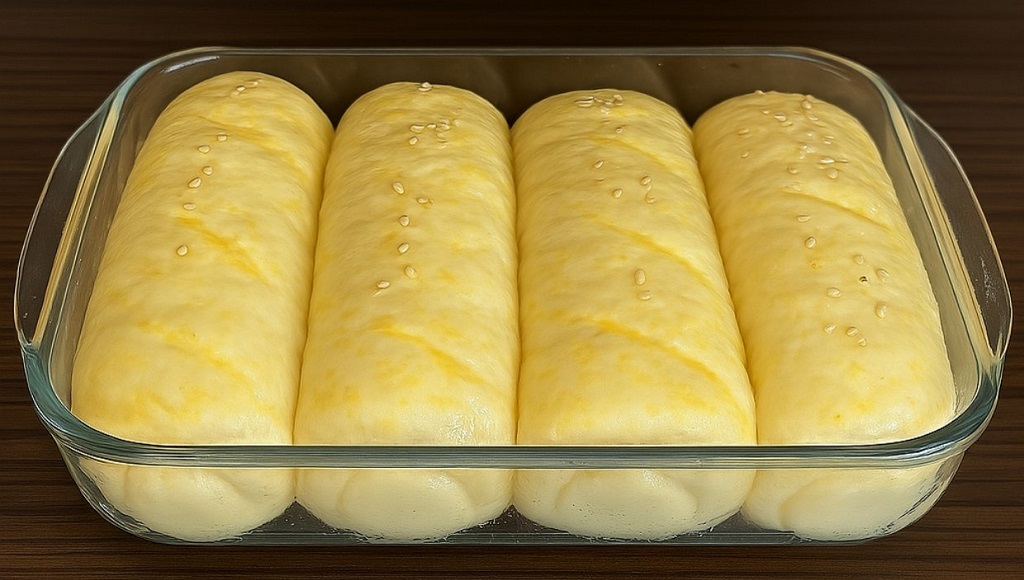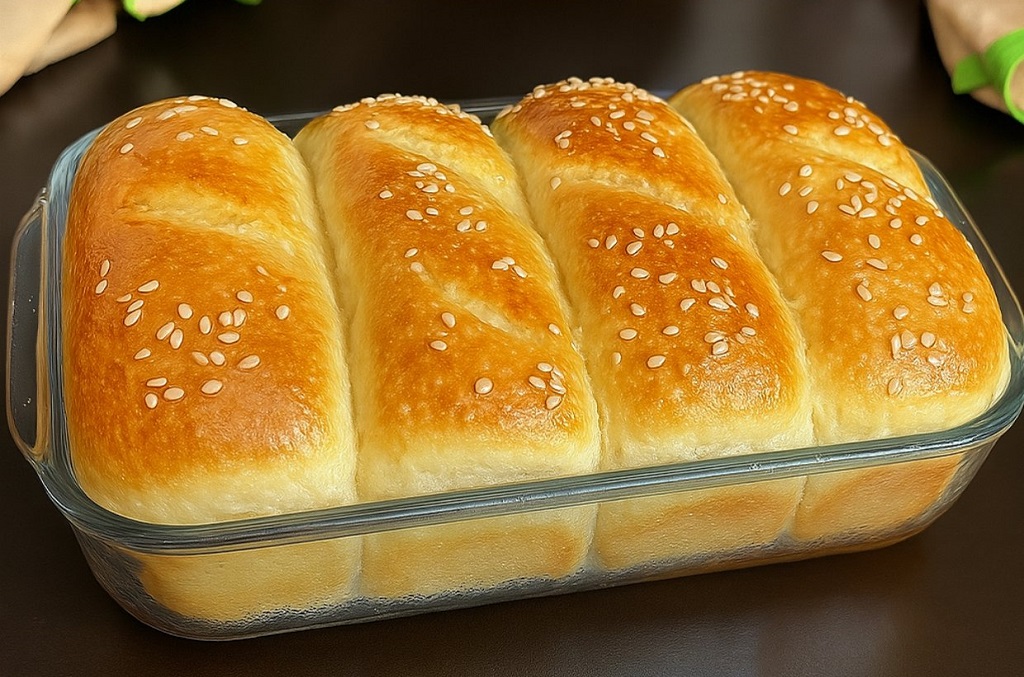This soft milk bread is everything you dream of in a homemade loaf pillowy, slightly sweet, buttery, and perfect for just about anything. As a chef who has kneaded more dough than I can count, this is one of those bakes I never get tired of. It’s comforting, versatile, and shockingly easy once you’ve got the basics down.
Whether you’re enjoying it fresh from the oven with butter, using it for the fluffiest French toast, or crafting the most delicate sandwich, this milk bread is a game changer. The secret? Warm milk, the right knead, and a slow, gentle rise. Let’s dive in you’ll want this recipe in your back pocket forever.
“A well-made milk bread is like a soft cloud with flavor it elevates even the simplest meal.” – @DailyDoughWhisperer
Why You’ll Love This Soft Milk Bread
- Incredibly soft texture: Thanks to milk, butter, and egg enriching the dough.
- Delicate sweetness: Slight sugar gives it a subtly sweet profile that pairs with both savory and sweet toppings.
- Easy to shape and bake: Rolls, loaves, braids you name it, this dough handles it.
- Freezer-friendly: Makes a great batch bake and stores well for future meals.
- Beginner-friendly: Simple steps, everyday ingredients, no special tools needed.
Looking for more soft and versatile bread? Check out our cloud-soft condensed milk bread or the pillowy fluffy milk buns both melt-in-your-mouth delicious!
Ingredients
- 1 cup warm milk (not hot – around 110°F)
- 2 1/4 teaspoons active dry yeast
- 1/4 cup sugar
- 1/4 cup unsalted butter, melted
- 1 egg
- 3 1/2 cups all-purpose flour
- 1 teaspoon salt
Step by Step Directions
1: Activate the Yeast
- In a bowl, combine the warm milk, yeast, and a pinch of sugar.
- Let it sit for 5-10 minutes until foamy and activated.
2: Combine Wet Ingredients
- Add the rest of the sugar, melted butter, and egg to the yeast mixture.
- Whisk or stir until smooth.
3: Mix in Dry Ingredients
- Gradually add the flour and salt to the wet mixture.
- Stir until a sticky dough forms, then transfer to a floured surface.
4: Knead the Dough
- Knead for about 10 minutes until the dough is smooth and elastic.
- If the dough sticks too much, add a light sprinkle of flour but don’t overdo it.
5: First Rise
- Place dough in a greased bowl and cover with a towel.
- Let it rise in a warm place for 1 to 2 hours, or until doubled in size.
6: Shape and Second Rise
- Punch down the dough, divide into equal portions, and shape into balls, loaves, or rolls.
- Place into a greased pan, cover, and let rise another 30-45 minutes.
7: Bake
- Preheat oven to 350°F (180°C).
- Bake for 25-30 minutes or until golden brown on top.
- Optional: Brush with melted butter as soon as it comes out for a glossy, soft crust.
8: Cool and Enjoy
- Let bread cool for at least 15 minutes before slicing to preserve the structure and moisture.
“Soft milk bread is what happens when a simple loaf gets the royal treatment.” – @BreadEleganceChef

Pro Tips for Perfect Milk Bread
- Warm milk only: Too hot will kill the yeast, too cold won’t activate it properly.
- Use fresh yeast: Check your expiration date for best rise results.
- Don’t skimp on kneading: This builds the gluten structure for that iconic pillowy crumb.
- Let it rest: A longer rise equals better flavor and softness.
Love breads with rich, fluffy textures? Then you must try our milk brioche and 10-minute skillet bread both guaranteed to wow your family and guests.
Delicious Ways to Customize Soft Milk Bread
Make It Sweet or Savory
One of the best things about this soft milk bread is its incredible flexibility. As a chef, I love recipes that can wear multiple hats. With a few tweaks, you can turn this dough into a decadent sweet bread or a savory sandwich loaf. Here are my go-to customizations:
- For sweet bread: Add 1 tsp vanilla extract and 1/2 tsp almond extract to the wet ingredients. Mix in raisins, cranberries, or mini chocolate chips before shaping.
- For savory bread: Stir in 1/2 cup shredded cheddar, fresh herbs, or roasted garlic into the dough before the first rise. A sprinkle of parmesan on top before baking adds extra flavor and crispiness.
- Filled rolls: Roll out portions of dough and fill them with cream cheese, jam, or even a savory sausage mix for a surprise in every bite.
Love switching things up? Try our versatile crazy dough recipe that works for everything from pizza to cinnamon rolls!
“The same dough, shaped and flavored differently, gives you endless possibilities.” – @CreativeCrustsChef
Serving Ideas for Every Occasion
Everyday Meals or Special Celebrations
This milk bread can elevate a humble meal or shine at a celebration. Here’s how I love to serve it depending on the occasion:
- Breakfast: Toast slices and top with butter and honey or peanut butter and banana.
- Lunch: Use as sandwich bread with deli meats, cheese, and crisp veggies.
- Dinner: Serve warm rolls alongside soups like cowboy soup or hearty vegetable soup.
- Special events: Shape into braided loaves or rolls, glaze with egg wash, and sprinkle with sesame seeds for presentation-ready bread.
Looking for more soft breads to pair with meals? You’ll also love our homemade Nutella doughnuts or milk brioche recipe.
Mastering the Texture: What Makes Milk Bread So Soft?
The Science Behind the Fluff
What sets soft milk bread apart from regular white bread is its uniquely tender and almost “bouncy” texture. As a chef, I find this recipe incredibly rewarding because it teaches the importance of ingredient balance and technique. Let’s break down exactly why this bread comes out cloud-like, and how you can guarantee those results every time.
- High hydration (milk): Unlike water, milk contains fat and sugars that add softness and a slightly sweet flavor while enhancing the golden-brown crust.
- Butter and egg enrichment: These fat-rich ingredients make the dough more tender and flavorful, contributing to that silky bite milk bread is famous for.
- Proper kneading: This step develops gluten the protein that traps air during rising. Without enough kneading, you’ll end up with a dense or crumbly loaf.
- Double rise technique: The first rise builds airiness, and the second rise ensures the final texture is fine and uniform with a beautiful dome top.
If you’re intrigued by the texture science behind bread, our Japanese cheesecake is another recipe that plays with airiness and smooth structure for a feather-light finish.
“Soft bread isn’t magic it’s milk, fat, heat, and patience all working together.” – @ProofedAndPerfected
Signs Your Dough Is Perfectly Kneaded
One of the most common beginner baking issues I see is under-kneading or even over-kneading dough. Knowing when to stop is a skill you’ll sharpen with practice, but here are signs I always look for to confirm the dough is just right:
- Smooth and elastic texture: The dough should feel soft, slightly tacky, and bounce back when gently poked.
- Windowpane test: Stretch a small piece of dough between your fingers. If it forms a thin, translucent “window” without tearing, it’s ready.
- No large cracks: A well-kneaded dough is unified and smooth with no visible flour patches or splitting.
If you’re still unsure, take your time. Kneading for 8-10 minutes by hand is a safe bet. Or if you’re using a stand mixer, 5-7 minutes with a dough hook will do the trick.
Love hands-on recipes like this? Try our homemade bomboloni another knead-by-hand favorite that rewards patience with cloud-soft results.
Shaping Techniques for Bakery-Style Presentation
Turn Simple Dough into Stunning Loaves
Shaping your bread doesn’t just affect how it looks it influences how it rises and bakes. Whether you’re baking this milk bread in a loaf pan or as individual rolls, here are my favorite shaping methods for show-stopping results:
- Pull-apart rolls: Divide the dough into small balls and nestle them in a greased round cake pan for a soft, blooming effect.
- Braided loaf: Split dough into three strands, braid like hair, and place in a loaf pan for beautiful tear-apart texture.
- Classic sandwich loaf: Roll dough into a tight rectangle and place in a standard loaf pan for uniform slices.
- Mini buns: Great for kids or appetizers bake in a muffin tin and brush with egg wash for shine.
Each shape brings a different experience to the table. For more creative breads with stunning visual appeal, try our fluffy blender cake or vanilla cupcakes both transform basic batters into showpieces.
“A good bread tastes great. A beautifully shaped bread? That’s how you make people remember it.” – @LoafGoalsChef
Finishing Touches Before and After Baking
To take your milk bread from homey to heavenly, consider these easy yet impactful finishing steps:
- Egg wash: Beat 1 egg with a tablespoon of water and brush on before baking for a shiny, golden crust.
- Melted butter: Brush immediately after baking for a soft, supple crust that melts in your mouth.
- Milk wash: For a softer sheen, brush with plain milk instead of egg before baking.
- Toppings: Add sesame seeds, poppy seeds, or even everything bagel seasoning for extra texture and flavor.
If you’re obsessed with crust perfection, you’ll also enjoy our homemade cinnamon rolls where glazes and toppings create bakery-quality finishes every time.
“That buttery shine on top? It’s your bread’s way of smiling back at you.” – @BakeFinishFlourish
Frequently Asked Questions
Can I use instant yeast instead of active dry yeast?
Yes! If using instant yeast, there’s no need to proof it first. Simply mix it directly into the dry ingredients and proceed with the recipe. Reduce the rise time slightly since instant yeast works faster.
Can I use plant-based milk?
Definitely. Almond milk, oat milk, or soy milk can replace dairy milk. Just make sure it’s warm not hot so it activates the yeast properly.
Why is my bread not rising?
This can happen if your yeast is expired, the milk was too hot, or your dough was in a cool environment. Always ensure your milk is around 100°F-110°F and proof in a warm, draft-free spot.
Can I freeze the dough or baked bread?
Yes! You can freeze the shaped dough before the second rise, or freeze fully baked loaves after cooling. Thaw frozen dough overnight in the fridge and allow to rise before baking. For baked loaves, slice and freeze, then toast as needed.
Can I make this in a bread machine?
Yes. Add ingredients in the order recommended by your bread machine (usually liquids first), and use the dough or basic white bread setting.
“A few simple questions can turn a good loaf into a flawless one always ask, always tweak, always bake again.” – @KitchenCuriousBaker
